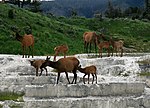The Leopold Report, officially known as Wildlife Management in the National Parks, is a 1963 paper composed of a series of ecosystem management recommendations that were presented by the Special Advisory Board on Wildlife Management to United States Secretary of the Interior Stewart Udall. Named for its chairman and principal author, zoologist and conservationist A. Starker Leopold, the report proved influential for future preservation mandates.
After several years of public controversy regarding the forced reduction of the elk population in Yellowstone National Park, Udall appointed an advisory board to collect scientific data to inform future wildlife management of the national parks. The committee observed that culling programs at other national parks had been ineffective, and recommended different management of Yellowstone's elk population. In addressing the goals, policies, and methods of managing wildlife in the parks, the report suggested that in addition to protection, wildlife populations should be managed and regulated to prevent habitat degradation. Touching upon predator control, fire ecology, and other issues, the report suggested that the National Park Service (NPS) hire scientists to manage the parks using current scientific research.
The Leopold Report became the first concrete plan to manage park visitors and ecosystems under unified principles.
